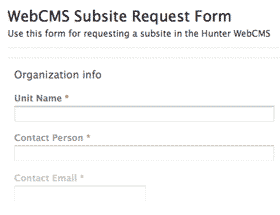What are roles?
Roles within the WebCMS define what a given user can and cannot do within a given subsite.
Only the subsite's Staff Manager can assign roles to other users.
A user is considered a "member" of a subsite if they are assigned a role in that subsite.
When you enter a particular subsite, the view that you see depends on the roles (or "privileges") that have been granted to you for that subsite. Your roles may differ by subsite if you have access to more than one. For example, you may have permission to edit and publish on one subsite, but only add content on another.
The purpose of adding users with varying roles is to control a user's capability to affect content and navigation. For example, you may want to allow a college assistant to create new content, but publishing should be reserved for the department head or a department administrator.
It’s a good idea to decide, in conjunction with others, the appropriate roles for various people in your organization.
The available roles within the WebCMS are:
- Staff Site: A person with this role is usually refered to as a "staff manager" or "staffer". This person determines who does what within the subsite. Their main purpose is to assign roles to other users. In addition, staffers can change roles based on personnel or organizational changes. It is recommended that the staff site role be held by someone in the department or office who can assign people to specific tasks and duties relating to public content. A staff manager does not necessarily play a day-to-day role in managing the website; therefore, this would be a good role for a department chair or office director.
- Publish Content: Anyone with this role is accountable for what is seen by the public. Ideally, a publisher is someone highly-placed in a department or office, such as a department chair or office director.
- Review Content: This role should be assigned to a user who can write and edit well. This person may be a unit head or a team leader, and is generally tasked with making sure that content is spelled correctly, grammatically correct, and strikes the right tone of voice before publication. Often, this role is combined with the Write Content role, to allow the Reviewer to edit content that others have created.
- Write Content: A person with this role is able to edit any content within the subsite, even content created by others. Examples of "authors" might be college assistants, volunteers, or anyone on staff who understands a topic well enough to write about it.
- Plan/Design Site: A person with this role can create new pages, create new folders, manage portlets, manage navigation, and alter theme settings. This would be a good role for an outside consultant or designer who is allowed to shape the navigation and organization of all content, but who will not be able to edit or approve content for publishing.
- Add New Content: A person with this role is able to create new pages and directories, but has no editorial role. By default, they are unable to affect what is seen by the public and are unable to alter the navigation and organization of files and folders in the subsite.
- View Unpublished Content: A person with this role can view all content in a subsite, even if it has not been published. This role does not give the user any editing rights.
Notes:
- Users can be given as many roles as their staff manager deems fit. In some cases, a single person is given all roles and is made solely responsible for their department or office's website. In other instances, a team of several people may all work on the same subsite, with different roles assigned to each individual.
- Staff managers are given the Staff Site role when their subsite is first created. If staffers wish to take on additional roles, they must manually assign these roles to themselves.
- Roles are generally assigned at the subsite level, which gives each user responsibility over the entire website. However, it is also possible to assign roles within a specific folder. For example, departments will often create a folder for each faculty member and then assign each person roles within their personal directory.






